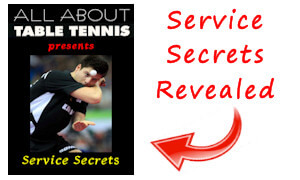You Are Here: Home » How to Play Table Tennis » Return of Serve Tactics
Tactics in Table Tennis
One of the most important tactics in table tennis is the return of service.
Discover how to improve yours and win more matches
By Martin Hughes
Owner and Editor
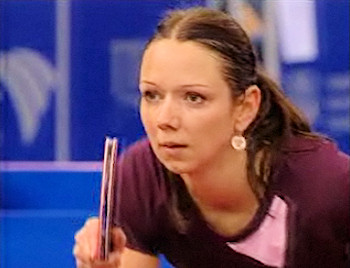
Tactics are very important in table tennis because they're used (in conjunction with your technical ability) to force your opponent to make an error or play a weak shot, which means that you'll be more likely to win the point.
And one of the most important tactics in table tennis is the return of service.
It's well known that the table tennis serve is the most important stroke in the game - because it provides the only situation in which you have total control over how and where you play the ball.
But the return of service is the second most important stroke in the game - because it provides the first opportunity for you to play the ball.
So if you're going to be successful and implement your own tactics in table tennis, you'll need to master the return of serve because if you don't develop a good return of service, you'll always lose to a player who has better serves than you.
RECOMMENDED TABLE TENNIS BOOK
Table Tennis Service Secrets
 |
Discover the fastest way to improve your table tennis by 30% Improving your service and return of service will add three points, or more, to every game you play. Click here for more details |
RECOMMENDED TABLE TENNIS BOOK
Table Tennis Service Secrets

Discover the fastest way to improve your table tennis by 30%
Improving your service and return of service will add three points, or more, to every game you play.
Click here for more details
TABLE TENNIS EXPERT
REVEALS HIS SECRETS
Click Here For Details

Click here for a large selection of
table tennis equipment at Megaspin *

Click here for a large selection of
table tennis equipment at Bribar *
^ Top of page ^
So let's first take a look at the ...
Objective of the return of service
Implementing your own tactics in table tennis start with the return of serve.
When returning serve, the objective is to put your opponent under time pressure and prevent them from playing their next stroke as they intended, so you should always try to play your shot as early as possible and vary your returns.
TABLE TENNIS EXPERT
REVEALS HIS SECRETS
Click Here For Details

Click here for a large selection of
table tennis equipment at Megaspin *

Click here for a large selection of
table tennis equipment at Bribar *
^ Top of page ^
But first you'll need to...
Read the spin
Before you can successfully return your opponent's serve, you first need to be able to determine (and then counteract) the spin which the server puts onto the ball.
To determine the type and quantity of spin on the ball, you'll need to watch...
- the angle of the racket as it strikes the ball
- the trajectory of the ball, and
- the logo on the ball itself
The angle of the racket will indicate if the serve has backspin, no spin or topspin whilst the directional movement of the racket as it hits the ball will indicate whether it's left or right sidespin.
By watching the logo on the ball - particularly on a short or slow service - you can determine how much spin is on the ball.
If the logo can be seen clearly, then the serve will have little or no spin, whilst if it is blurred then it usually indicates heavy (excessive) spin.
^ Top of page ^
Let's now take a look at the...
Principles in returning spin services
In general, when returning serve, the following principles will apply...
- Sidespin serves - take note of where your opponent's racket started from and aim your return in that direction
- Backspin serves - lift the ball by using an upward brushing action with your racket,
or use an open racket angle to play a push return
- Topspin serves - use a closed racket angle to play a topspin return
^ Top of page ^
So let's now take a look at the...
Limitations on return of serve
The type of shots you'll be able to play on return of serve will be dictated by the type of service you receive.
Basically, the service will either be "short" or "long".
A "short" service is one where the ball would bounce more than once on your side of the table if you didn't hit it after the first bounce on your side of the table (which you must do)...
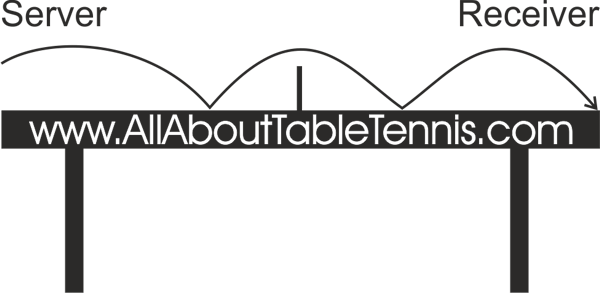
whereas a "long" serve is one where the ball clears your end line after the first bounce ...
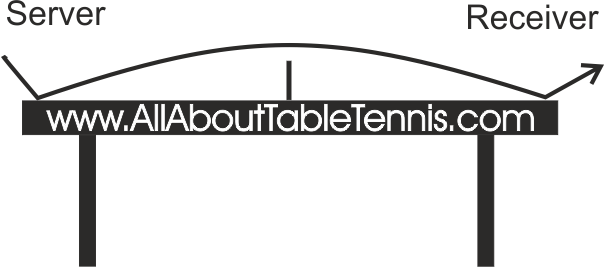
^ Top of page ^
So let's see which shots you can play for each...
Return of service variations
A short serve will allow you to choose from three alternatives. You can play...
- a short push
- a long attacking push or
- a flick shot
whereas a long serve allows you a greater number of choices. You can play...
- a push
- a block
- an attacking topspin
- a counter topspin or
- a defensive chop
^ Top of page ^
So how should you play these strokes...
Technique for returning short serves
In order to return a short service, you first need to move forward. So by positioning your right leg under the table you can get as close as possible to the ball, play your shot, and then move back out again.
If you're right-handed, your feet will need to be in the following positions...
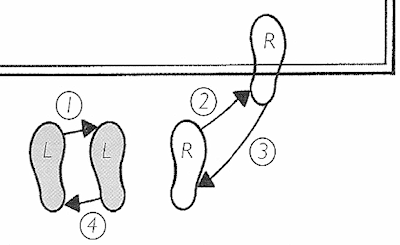
Moving forward enables you to play your shot with a bent arm and ensures that you can use both your forearm and your wrist to their maximum.
Once you've moved in close enough to return the short service, you can then choose from one of the three alternative shots...
- The objective of a short push is to return the ball short with different amounts of spin,
and to hit the ball just after it has bounced so that you reduce the amount of time your opponent has to react.
- The objective of the long attacking push is to get greater depth and speed on the ball.
This gives your opponent less time to play an attacking shot, and gives you an opportunity to be aggressive on your next shot.
- The objective of the flick shot is to force your opponent back on their heels, thus giving you the initiative.
It's also important that you vary your return of serve (just as it's important that you vary your own service), so that your opponent doesn't know if your return is going to be short or long.
A fast, long return is good against players who are not as strong in attack, as it will force them to play a weak attacking stroke which you can then attack yourself.
^ Top of page ^
But what about...
Returning long serves
One of the most important tactics in table tennis is to play offensively.
You should always try to attack long services, but it's important that you vary the placement of your first attack as well as varying the spin and speed.
A fast, attacking return will cause your opponent to play a weak attacking stroke which you can then attack again.
As top players use the short serve more frequently than the long serve, it's important that you take the initiative when you're presented with a long service.
It's also essential to be able return the service to different places on the table.
^ Top of page ^
So it's important that you...
Practice your return of serve
So, just as it's important to practice your service, it's just as important to practice your return of serve as they are an important part of your tactics in table tennis.
All the possible variations should be practised regularly until you decide on your favourite returns.
Your favourites should then be practised more, but the others should not be neglected completely as they too may be needed on occasions for extra variation.
RECOMMENDED TABLE TENNIS BOOK
Table Tennis Service Secrets
 |
Discover the fastest way to improve your table tennis by 30% Improving your service and return of service will add three points, or more, to every game you play. Click here for more details |
RECOMMENDED TABLE TENNIS BOOK
Table Tennis Service Secrets

Discover the fastest way to improve your table tennis by 30%
Improving your service and return of service will add three points, or more, to every game you play.
Click here for more details
^ Top of page ^
| MORE PAGES ABOUT HOW TO PLAY TABLE TENNIS |
|---|
For more information on how to play table tennis and improve your game, take a look at my other tips and techniques articles...
Basic Skills
Advanced Skills
Strategies and Tactics
Tips
Skill Tests
Exercises
E-Books
|
Click here for a large selection of
table tennis equipment at Megaspin *

Click here for a large selection of
table tennis equipment at Bribar *
^ Top of page ^
You Are Here: Home » How to Play Table Tennis » Return of Serve Tactics
